#abcb rhyming scheme
Explore tagged Tumblr posts
Text
untouchable(s)
You are no more holy than The dust on every hand That carved those jewels from the earth And lifted bread from land
You are no more mighty than A pebble by the sea With each sequential drop the stone Pays mass for memory
Goliath who walks the ground With eyes up high and tall The lamb you bleed so readily Waits eager for your fall
4 notes
·
View notes
Text
9 Traditional Forms of Poetry:
Sonnet- 14 lines, written in iambic pentameter (a meter with five pairs of unstressed and stressed syllables per line), with the rhyme scheme ABAB (Also known as Shakespearean)
Haiku- traditional Japanese form with 3 lines and a common syllable pattern of 5-7-5. It often focuses on nature. (You can also do patterns of 7-5-7 or 3-5-3)
Villanelle- 19 lines with five three-lined verses (ABA) followed by a four-line stanza (ABAA).
Limerick- a humorous five-line poem with a rhyme scheme of AABBA and a specific rhythm.
Ballad- A narrative poem with song-like qualities, usually written in four-line stanzas with a rhyme scheme. (like ABAB or ABCB)
Ode- a formal, often ceremonious lyric poem that addresses or celebrates a person, place, thing, or idea. It typically follows a specific structure.
Elegy- a reflective poem that grieves the loss of someone or something.
Sestina- a complex form with six stanzas of six lines each, followed by a three-line conclusion stanza.
Pantoum- composed of quatrains where the second and fourth lines of each stanza become the first and third lines of the next stanza.
There are more but this is all for now!
#writeblr#writers on tumblr#creative writing#writing#writerscommunity#writers and poets#writing blog#tumblr writing community#writers#tumblr writers#writers block#writing advice#writing community#writing ideas#writing inspiration#writing stuff#writing tips#poets on tumblr#poetic#poetry#poetsandwriters#the tortured poets department#poems#original poem#poems on tumblr#spilled poetry#poetry tips
75 notes
·
View notes
Note
Would you please do a analysis of the famous "lik the bred" poem by reddit user poem_for_your_sprog?
my name is Cow, and wen its nite, or wen the moon is shiyning brite, and all the men haf gon to bed - i stay up late. i lik the bred.
"i lik the bred" is like maybe my favorite internet poem of all time! of course!
full scansion:
◡ – / ◡ – my name / is Cow, ◡ – / ◡ – and wen / its nite, ◡ – / ◡ – or wen / the moon ◡ – / ◡ – is shiy/ning brite, ◡ – / ◡ – and all / the men ◡ – / ◡ – haf gon / to bed- ◡ – / ◡ – i stay / up late. ◡ – / ◡ – i lik / the bred.
metrical form: iambic dimeter rhyme scheme: ABCB other notes: This could also be analyzed as AABB iambic tetrameter, but what I love about it is that after one long sentence, it breaks the syntactic unit in the middle of a couplet to create a surprising ending. Ink has been spilled over whether the non-standard orthography of this poem is intended to evoke archaism (as it is about an event that happened in an 18th-century historical reenactment) or the animal speaker (cf. the orthography of lolcatz memes).
#iambic#dimeter#iambic dimeter#iambic tetrameter#my name is cow#bredlik#i lik the bred#queued#requested#in my head the tune of the bredlik poem is greensleeves/what child is this but other tunes work
119 notes
·
View notes
Text
Another thing I love about the Les Mis musical (which I'm curious if they have in the French) is the hanging rhymes.
At certain points in the musical, the rhyme scheme and music make you feel like there should be a word that will rhyme with another, particular line. Instead of resolving it, though, it just...hangs. It never gets the satisfying resolution you want. And they use this so well, especially in Valjean's Soliloquy (which makes sense, as he is a character that does feel perpetually "unresolved"--always on the run, unable to rest).
First, there's a line early in the song:
My life he claims for God above--
Can such things be?
Now, technically, this line does have a rhyme, in the stanza before, but the music makes you forget about it:
Yet why did I allow that man
To touch my soul and teach me love?
He treated me like any other;
He gave me his trust! He called me brother!
By reverting to a couplet here, instead of keeping an alternating rhyme scheme, it makes the stanza feel complete. By the time you start the next phrase ("My life he claims for God above"), which is furthermore on a rising part of the melody, you kind of assume that it will get another resolution in its own stanza. But it doesn't! Instead we hear:
For I had come to hate the world;
This world that always hated me!
Our ears are primed to hear the word love again, or at the very least the word above reminds us of it--but instead we get two instances of the word hate! Valjean had hoped for love, but instead, hatred was all he was met with; the same thing shows up in the literal construction of the song!
There's another instance of a hanging rhyme at the end of his Soliloquy, which is probably the perfect example of how to use these well. His penultimate stanza is:
I am reaching, but I fall
And the night is closing in,
As I stare into the void
To the whirlpool of my sin;
This establishes an ABCB rhyme scheme: lines 2 and 4 rhyme. We expect the last stanza to follow this:
I'll escape now from that world,
From the world of Jean Valjean!
Jean Valjean is nothing now--
Another story must begin!
Yet here, line 2 does not rhyme with line 4! The word "Valjean" doesn't get a rhyme--it's left hanging, because "Jean Valjean is nothing now"! That name no longer defines the course of Valjean's story!
But what does define it? What does the final line rhyme with?
"My sin."
Even with his new life, Valjean won't be able to leave that behind.
What excellent wordsmithing!
#jean valjean#les miserables#les mis#meta#song analysis#my meta posts#kay can i just catch my breath for a second#kay is a musical theater nerd#kay is a classical literature nerd#gonna add on the marius one as a reblog but these aren't the only instances!!
43 notes
·
View notes
Text
i genuinely love Eagles Can Fly so much. like it's such a simple concept but it's done so well i just. asdjhsfkjsd. slightly incomprehensible yapping ahead

as Natsuki says in-game, the poem is about giving up. pretty straightforward. i think there's also something to say about giving up and failing while other people (animals) around you are being successful and overall feeling inferior to others, which kind of plays into her continuously having to justify her interests and writing style in order to be taken seriously.
with that in mind, we take a look at the rhythmic structure of the poem (rhythmic structure may or may not be an actual term, but it sounds right). Natsuki specifically highlights the rhyme scheme of this poem and her choice to break the rhyme in the last line of the poem. the first four lines of the poem follow an ABCB rhyme scheme, so you'd expect the next four to follow this as well - but nope, it's ABBC. as Natsuki says, this subverts the reader's expectations and make the last line hit harder. the last line is also an outlier as the only line with 5 syllables and not following the preestablished format of [animal] can [verb], futher reinforcing its role in breaking the flow of the poem. on a more meta level, breaking a rhyme is also an action of giving up (on the structure of the poem).
it's also worth noting the rhyme in "fly" and "try", which already breaks the rhyme scheme without even considering the last line. when reading the poem, this results in the line feeling slightly out of place - like you skipped a line or something. this lends itself to the idea that even when people are doing the thing they do best - trying - they still can't do it in a way that feels natural. "trying" as an action also feels like less of an accomplishment compared to the other actions, further playing into the idea of inferiority.
in terms of literary devices, there's not much else to say about the poem which i think is the best thing about it. its sole purpose is to play with the rhyming and word use and then throw it back in your face but it's used so well that you really don't need anything else.
44 notes
·
View notes
Text
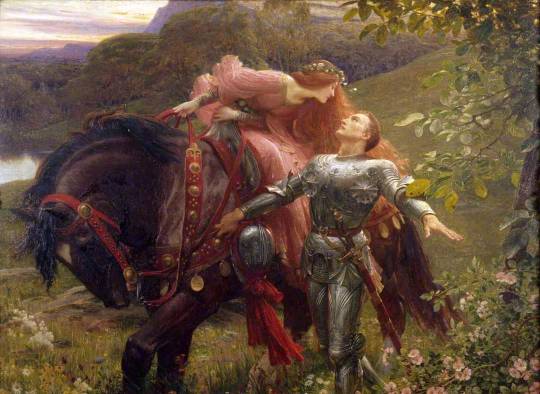
Frank Dicksee (British painter and illustrator) 1853 - 1928
La Belle Dame Sans Merci, ca. 1902
oil on canvas
13 x 18 cm. (5.12 x 7.09 in.)
Bristol City Museum and Art Gallery, Bristol, United Kingdom
© photo Bristol City Museum and Art Gallery,
La Belle Dame sans Merci is a ballad written by the English poet John Keats. It exists in two versions, with minor differences between them. The original was written by Keats in 1819. He used the title of a 15th century poem by Alain Chartier, though the plots of the two poems are different. The poem is considered an English classic, stereotypical to other poems of John Keats, a Romantic poet. It avoids simplicity of interpretation despite simplicity of structure. At only a short twelve stanzas, of only four lines each, with a simple ABCB rhyme scheme, the poem is nonetheless full of enigmas, and has been the subject of numerous interpretations.
Keats' poem describes the condition of an unnamed knight who has encountered a mysterious woman who is said to be "a faery's child." It opens with a description of the knight in a barren landscape, "haggard" and "palely loitering". He tells the reader how he met a mysterious but very fair lady whose "eyes were wild." The damsel told the knight that she "loved him true" and took him to her "elfin grot," but upon arriving there, she "wept, and sigh'd full sore." Having realized something that the knight does not yet understand, the mysterious maiden sets the knight to sleep. The knight has a vision of "pale kings and princes," who cry, "La Belle Dame sans Merci [the beautiful, pitiless damsel] hath thee in thrall!" He awakes to find himself on the same "cold hill's side" on which he continues to wait while "palely loitering."
"La Belle Dame sans Merci" was a popular subject for the Pre-Raphaelite painters. It was depicted by Sir Frank Dicksee, Frank Cadogan Cowper, John William Waterhouse, Arthur Hughes, Walter Crane, and Henry Maynell Rheam. It was also satirized in the December 1, 1920 edition of Punch magazine.
* * *
This painting is based on La Belle Dame Sans Merci by John Keats.
La Belle Dame Sans Merci
I
Ah, what can ail thee, wretched wight,
Alone and palely loitering;
The sedge is wither'd from the lake,
And no birds sing.
II
Ah, what can ail thee, wretched wight,
So haggard and so woe-begone?
The squirrel's granary is full,
And the harvest's done.
III
I see a lily on thy brow,
With anguish moist and fever dew;
And on thy cheek a fading rose
Fast withereth too.
IV
I met a lady in the meads
Full beautiful, a faery's child;
Her hair was long, her foot was light,
And her eyes were wild.
V
I set her on my pacing steed,
And nothing else saw all day long;
For sideways would she lean, and sing
A faery's song.
VI
I made a garland for her head,
And bracelets too, and fragrant zone;
She look'd at me as she did love,
And made sweet moan.
VII
She found me roots of relish sweet,
And honey wild, and manna dew;
And sure in language strange she said,
I love thee true.
VIII
She took me to her elfin grot,
And there she gaz'd and sighed deep,
And there I shut her wild sad eyes -
So kiss'd to sleep.
IX
And there we slumber'd on the moss,
And there I dream'd, ah woe betide,
The latest dream I ever dream'd
On the cold hill side.
X
I saw pale kings, and princes too,
Pale warriors, death-pale were they all;
Who cry'd - 'La Belle Dame sans merci
Hath thee in thrall!'
XI
I saw their starv'd lips in the gloam
With horrid warning gaped wide,
And I awoke, and found me here
On the cold hill side.
XII
And this is why I sojourn here
Alone and palely loitering,
Though the sedge is wither'd from the lake,
And no birds sing.
For the poem of Keats, click here:
http://englishhistory.net/keats/poetry/labelledamesansmerci.html
To hear the song composed by Charles Villiers Stanford (1852 -- 1924) on the text of Keats poem (poem there also included) listen at: http://www.youtube.com/watch?v=phRGiN5kQaw
10 notes
·
View notes
Text
So in Anne with an E, in episode 4 towards the end (4:17 left on netflix) there's a shot of Marilla reading from the book of Psalms, specifically 78.
What jumped out at me is that each verse has been turned into a quatrain (four lines) with a ABCB rhyme scheme. It's Ballad Stanzas!
So being the Jewish nerd that I am, I had to know 1) how Robert Alter and JPS translated the psalm and 2) what the heck translation this was (obv an xtian one).
It turns out that it's The Psalms of David in Metre aka The Scottish Psalter of 1650
For quick comparison Alter's first two verses, then JPS 1985, then the first two stanza from the 1650 Robert Alter 1 Hearken, my people, to my teaching. Lend your ear to the sayings of my mouth. 2 Let me open my mouth in a rhapsody, let me voice the verses of old, JPS 1985 1 Give ear, my people, to my teaching, turn your ear to what I say. 2 I will expound a theme, hold forth on the lessons of the past, Scottish Psalter 1650 1 Attend, my people, to my law; thereto give thou an ear; The words that from my mouth proceed attentively do hear.
2 My mouth shall speak a parable, and sayings dark of old; The same which we have heard and known, and us our fathers told.
But extra fun thing: this Scottish Psalter 1650 Psalm 78 is in Common Meter (specifically 8, 6, 8, 6). Which means you can sing this over all sorts of tunes! AZMON (the tune that Wesley's O for a Thousand Tongues uses), a number of other hymn tunes i'm sure, but ALSO: Gilligans Isle (repeating the last line), The House of the Rising Sun, and THE POKEMON THEME (verses)
#anyway yeah that's me being a nerd for an hour instead of watching#h2fox2.txt#anne with an e#awae#awae fandom
15 notes
·
View notes
Text
full scansion:
– / ◡ – / ◡ – / ◡ – Long / ago / there was / a cat, ◡ – ◡ / ◡ – / ◡ – Who swallowed / a ball / of yarn; ◡ – / ◡ – / ◡ – ◡ And when the cat had kittens, ◡ – / ◡ – / ◡ – They all / had swea/ters on.
metrical form: underlyingly, iambic trimeter rhyme scheme: ABCB other notes: an iamb is replaced with an amphibrach in lines 2 and 3. line 1 starts with an extra stress.

197K notes
·
View notes
Note
poem for you to scan if youre accepting them? this one's called "the pillars in pairs"
Through the door of golden pine
Down the creaking stairs,
With pale stone streaking granite gold
Of the pillars in pairs.
On the brick-and-mortar path
Near to sunlit mares
Within the light of the shining sun
‘Round the pillars in pairs.
Over hedges rosy-sweet,
By the grazing hares
Across the golden field of grass,
To the pillars in pairs.
T’wards the silver marble men
Near the statue’s hand,
Before the weeping ravens here,
The pairs of pillars stand.
Scansion:
– / ◡ – / ◡ – / ◡ – Through / the door / of gol/den pine – / ◡ – / ◡ – Down / the crea/king stairs, ◡ – / ◡ – / ◡ – / ◡ – With pale / stone strea/king gra/nite gold ◡ ◡ – / ◡ ◡ – Of the pil/lars in pairs. – / ◡ – / ◡ – / ◡ – On / the brick/-and-mor/tar path – / ◡ – / ◡ – Near / to sun/lit mares ◡ – / ◡ – / ◡ ◡ – / ◡ – Within / the light / of the shi/ning sun ◡ ◡ – / ◡ ◡ – ‘Round the pil/lars in pairs. – / ◡ – / ◡ – / ◡ – O/ver hed/ges ro/sy-sweet, – / ◡ – / ◡ – By / the gra/zing hares ◡ – / ◡ – / ◡ – / ◡ – Across / the gol/den field / of grass, ◡ ◡ – / ◡ ◡ – To the pil/lars in pairs. – / ◡ – / ◡ – / ◡ – T’wards / the sil/ver mar/ble men – / ◡ – / ◡ – Near / the sta/tue’s hand, ◡ – / ◡ – / ◡ – / ◡ – Before / the wee/ping ra/vens here, ◡ – / ◡ – / ◡ – The pairs / of pil/lars stand.
Metrical form: Each four-line stanza has the same rhythm, even though each line within the stanza is different: – / ◡ – / ◡ – / ◡ – (acephalous iambic tetrameter) – / ◡ – / ◡ – (acephalous iambic trimeter) ◡ – / ◡ – / ◡ – / ◡ – (iambic tetrameter) ◡ – / ◡ – / ◡ – OR ◡ ◡ – / ◡ ◡ –
The fourth line of the stanza is underlyingly an iambic trimeter. However, in all but the last stanza, this expected line is replaced with an anapestic dimeter: the same number of syllables, but broken into two feet instead of three.
Rhyme scheme: ABCB DBEB FBGB HIJI
#this is a cool one i like the stanza structure a lot! thanks anon!#irregular stanzas#Through the door of golden pine#anonymous#the pillars in pairs#requested#iambic tetrameter#iambic trimeter#iambic#tetrameter#trimeter#acephalous iambic tetrameter#acephalous iambic trimeter#anapestic dimeter#queued
15 notes
·
View notes
Text
Because I Could Not Stop To Rhyme
At various times in the past, I have featured bits and pieces from Judy Jo Small’s book “Positive as Sound, Emily Dickinson’s Rhyme.” I thumbed through the book again, and for the next few days I’ll share a few of Small’s comments about specific poems.
On the bottom of page 128 of her book, Small said, “The Dickinson poem most heavily laden with full rhyme, though, is probably this one, composed in otherwise conventional quatrains,” and I was completely surprised by the poem displayed at the top of page 129. It wasn’t what I expected at all.
Now granted, I don’t know off the top of my head which of Dickinson’s poems is the “most heavily laden with full rhyme,” but I didn’t expect this one.
Before I get to the poem that Small singled out, let me say that I – for fun – ran a Google-search on “which poem by Emily Dickinson uses the most rhyme,” and the AI-response, the first time I ran the search, was “Because I could not stop for Death.”

Say what?
The AI generator noted the ABCB rhyme scheme of the poem, but really – that’s about it. The poem actually employs only a few traditional rhymes, and the end-of-line rhymes are as follows: me/immortality, away/civility, ring/sun, chill/Tulle, ground/ground, and day/eternity. Not what I would call “heavily laden.”
Later, I ran the search a second time and got this: “While it's hard to definitively say which one absolutely uses the most rhyme due to Dickinson's unique style, "I'm Nobody! Who Are you?" by Emily Dickinson is often cited for its relatively regular rhyme scheme.”
Seriously? The poem has two stanzas, and the end rhymes are “too/know” and “frog/bog.”

I ran the search a third (and final) time, and this time I got, “While many of Emily Dickinson's poems utilize rhyme, one example of a poem that features a strong and frequent use of rhyme is ‘I dwell in Possibility.’”
Again, not a strong contender for the poem “most heavily laden with full rhyme.” The rhymes in that three-stanza poem are prose/doors, eye/sky, and this/paradise.

By the way, I checked the site for the Emily Dickinson Museum just to see if they happened to mention a poem (or more) that was “heavily laden” with rhyme. Their page (HERE) “Major Characteristics of Dickinson’ Poetry” includes a section entitled “Meter and Rhyme,” and the page focuses on the poem “I’ll tell you how the sun rose.” There are 16 lines in that poem, and the rhymes in the ABCB pattern are time/ran, begun/sun, stile/while, and gray/away.

The museum’s commentary includes this info: “Slant rhyme, or no rhyme at all, is quite common in modern poetry, but it was less often used in poetry written by Dickinson’s contemporaries. In this poem, for example, we would expect ‘time’ to rhyme with ‘ran.’”
Hmm…I think they meant to say, “we would NOT expect ‘time’ to rhyme with ‘ran,’” so I emailed them to ask.
Okay, so back to Judy Jo Small’s book and her (assertion) about “The Dickinson poem most heavily laden with full rhyme.” Any guesses as to which poem that might be? I’ll post it tomorrow.
1 note
·
View note
Text
Ballad Stanza
A ballad stanza is a four-line stanza commonly found in English ballads, characterized by a rhyme scheme of ABCB. The first and third lines are typically unrhymed and contain four metrical feet (often in iambic meter), while the second and fourth lines rhyme and also consists of four metrical feet. This structure contributes to the musical quality and storytelling nature of ballads. The Voting…
0 notes
Text
full scansion:
– / ◡ – / ◡ – / ◡ – mon/keys on / the in/terstate ◡ – / ◡ – / ◡ – igua/nas in / your home – / ◡ – / ◡ – / ◡ – all / my pa/tients kick / and bite ◡ – ◡ / ◡ – / ◡ – wild ani/mals I / have known
metrical form: Alternating lines of acephalous iambic tetrameter and iambic trimeter. rhyme scheme: ABCB other notes: Line 4 has an extra syllable between the first and second feet.
Was looking for a book today when I saw these various animal books all on the same shelf and noticed their titles made a nice little impromptu poem about veterinary medicine

#acephalous iambic tetrameter#acephalous iambic tetrameter and iambic trimeter#iambic#tetrameter#monkeys on the interstate#great-and-small#found poetry#queued
73K notes
·
View notes
Text
Can’t stop thinking about the guy I kissed in my dream months ago so I wrote a poem about it. Not gonna share it bc it’s not done (I don’t think) and I’m still pretty amateur but I wanted to share one part of it I liked.
So it starts with how the part of the dream I remember began: me, not wanting to develop a crush on someone I’d just met, but feeling some level of attraction. ABCB for the first two stanzas.
Next is the part where this person was dated to kiss me. The rhyme scheme and rhythm and tone fall apart in my shock.
Then, the person leans in and tells me to relax. Here, the pacing is quicker, each line containing multiple short phrases. AAAA rhyme. I have never kissed anyone, so I wanted to go back to rhyming but a different scheme. A new experience, but not a bad one.
The first half of the next stanza is AA, continuing about my feelings. Then… the second half is where I wake up. All pretty words, all rhyme, all the care put into structure is gone. Immediately. This is distinct from where it fell apart earlier. Where that one stuttered, this one shuts down and uses periods for the first time in the whole poem.
The structure of the poem is just as important to it as any given word choice.
#do you see the vision#almond rambles#sorry idk if anyone even cares I just had an Idea and wanted to share#I’d love to share this poem if I ever get it into a half decent shape#also fun fact is that I’ve posted this dream before on this blog#continuity in the almonddirge cinematic universe
0 notes
Text
A Pinch of Poetry: Quatrain
We’re going to do another simple one today, because we have to get through them in order to understand more complex poems. A quatrain can be a poem by itself or, more likely, part of a poem. A quatrain is a 4-line rhyme with rhyme schemes AABB, ABAB, ABCB, or ABBA. Though quatrains existed since Ancient Greece, Nostradamus is mainly credited with them, as he used them in his prophecies during…
0 notes
Text
From Concept to Composition: How to Write a Song in 10 Steps

Songwriting is a journey from a simple concept to a full-fledged composition. Breaking down the process into manageable steps can make it more approachable and enjoyable. Whether you're a seasoned songwriter or just starting, this 10-step guide will help you write a song from start to finish, transforming your initial ideas into a polished piece.
Conceptualization:
Finding Your Idea: The first step in songwriting is finding a concept or theme. This could be a personal experience, a story you've heard, or an emotion you want to express. Inspiration can come from anywhere, so keep an open mind and be ready to jot down ideas whenever they strike.
Defining Your Theme: Once you have an idea, define your theme. What is the core message or emotion you want to convey? Having a clear theme will guide your lyrics and melody, giving your song coherence and direction.
Research and Inspiration:
Listening to Music: Listen to a variety of songs in different genres to get inspired. Pay attention to how other songwriters structure their songs, the themes they explore, and the techniques they use.
Reading and Watching: Books, movies, and even everyday conversations can provide valuable inspiration. Note down interesting phrases, emotions, or scenarios that could be woven into your song.
Lyric Brainstorming:
Free Writing: Spend some time free writing about your theme. Write without worrying about rhyme or structure. This exercise can help you generate raw material that you can refine later.
Word Association: Use word association to expand on your theme. Start with a central word related to your concept and list any words or phrases that come to mind. This can help you find fresh angles and ideas for your lyrics.
Melody Creation:
Humming Melodies: Start by humming or playing different melodies over your lyrics. Don’t worry about perfection at this stage; the goal is to find a tune that complements your words.
Recording Ideas: Record your melodic ideas as you go. This way, you can revisit and refine them later. Sometimes, the best melodies come from spontaneous moments.
Chord Progressions:
Basic Chords: Begin with simple chord progressions that fit the key of your song. Common progressions like I-IV-V or ii-V-I are a good starting point.
Experimentation: Experiment with different chords to find combinations that enhance your melody. Don’t be afraid to try unconventional progressions to add uniqueness to your song.
Song Structure:
Verse-Chorus-Bridge: Familiarize yourself with common song structures such as verse-chorus-bridge. This traditional structure provides a framework that helps organize your ideas.
Dynamic Variation: Incorporate dynamic changes to keep the listener engaged. For example, build tension in the verses and release it in the chorus.
Drafting Lyrics:
First Draft: Write the first draft of your lyrics, focusing on getting your ideas down on paper. Don’t worry about perfection; you’ll refine them later.
Rhyming and Meter: Pay attention to the rhyme scheme and meter. These elements add musicality and flow to your lyrics. Common rhyme schemes include AABB, ABAB, and ABCB.
Refining the Melody:
Matching Melody to Lyrics: Adjust your melody to better fit the rhythm and mood of your lyrics. Ensure that the melody enhances the emotional impact of the words.
Vocal Range: Consider the vocal range of the intended singer. The melody should highlight their strengths and be comfortable to sing.
Arrangement:
Instrumental Arrangement: Decide on the instrumentation and arrangement of your song. This includes choosing which instruments will play the melody, harmony, and rhythm.
Adding Layers: Add layers to your arrangement to create depth and texture. This could include harmonies, backing vocals, and additional instruments.
Polishing and Finalizing:
Editing: Review your song and make necessary edits. This could involve tweaking lyrics, adjusting the melody, or refining the arrangement.
Feedback: Seek feedback from trusted friends, family, or fellow musicians. Constructive criticism can help you identify areas for improvement.
Final Adjustments: Make final adjustments to ensure your song flows smoothly and effectively conveys your intended message and emotion.
By following these 10 steps, you can systematically approach songwriting and transform your initial concept into a polished composition. Remember that songwriting is a personal and unique process, so don’t be afraid to experiment and find what works best for you. The most important thing is to enjoy the journey and let your creativity flow.
What’s your songwriting process like? Do you have any additional steps or tips that help you write songs? Share your experiences and advice in the comments below.
Related Articles:
For further reading, explore these related articles:
Deliver My Tune’s Exciting New Services! Ways to Beat Writer’s Block Know the Ways to Get the Music Sync Licensing
0 notes
Text
scansion:
– ◡ ◡ – Roses are red, – ◡ ◡ – Violets are blue. – ◡ – ◡ Rocks are shiny, ◡ – ◡ – I love their hue. ◡ – ◡ – ◡ – Such beauty in the old – ◡ ◡ – and in the new, – ◡ ◡ – ◡ Polished by rivers, – ◡ – ◡ ◡ – journeys, seasons, and dew.
metrical form: The first stanza is strictly dimeter with 4 syllables per line. In the second stanza the lines get increasingly longer and more varied: there are trimeter lines (line 5, line 8) and the resolution of one unstressed syllable into two unstressed syllables (lines 7 and 8). It gives a sense of expansiveness.
rhyme scheme: ABCB DEFE rhyming couplets
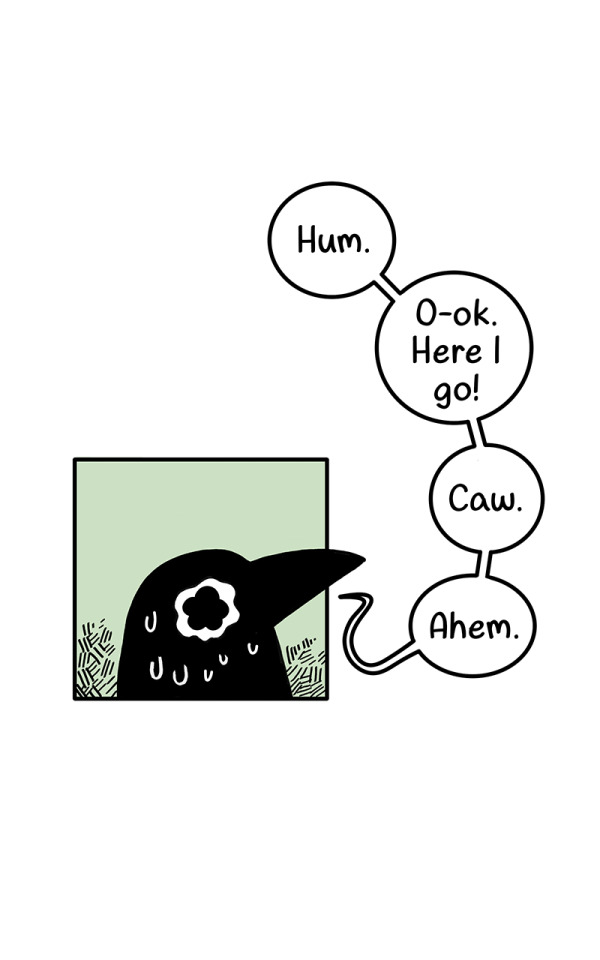

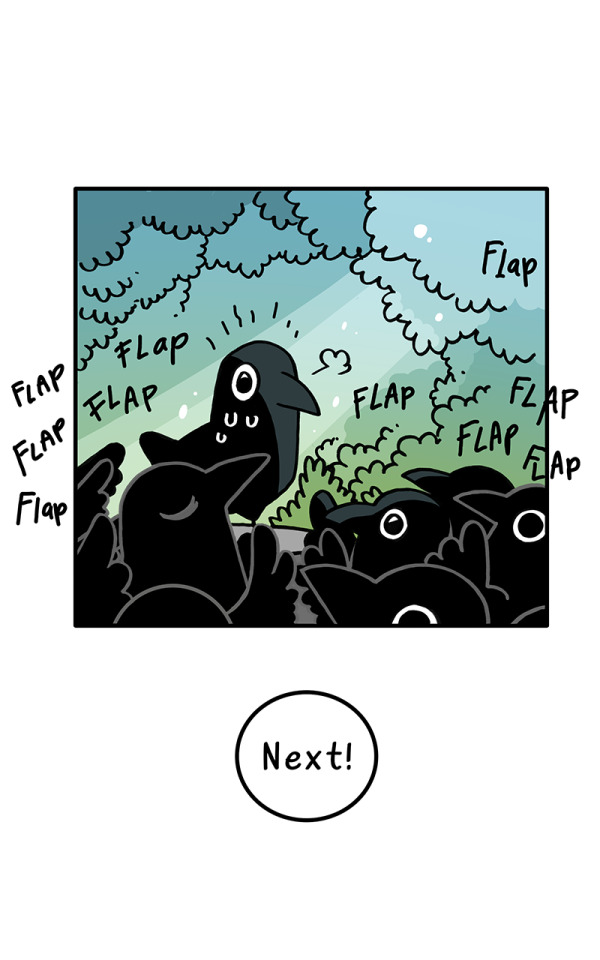
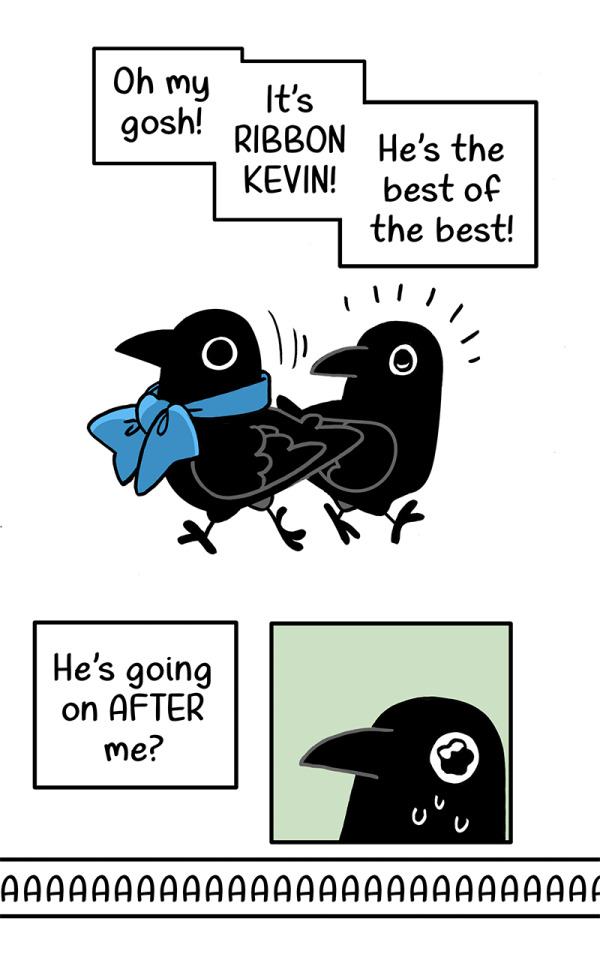
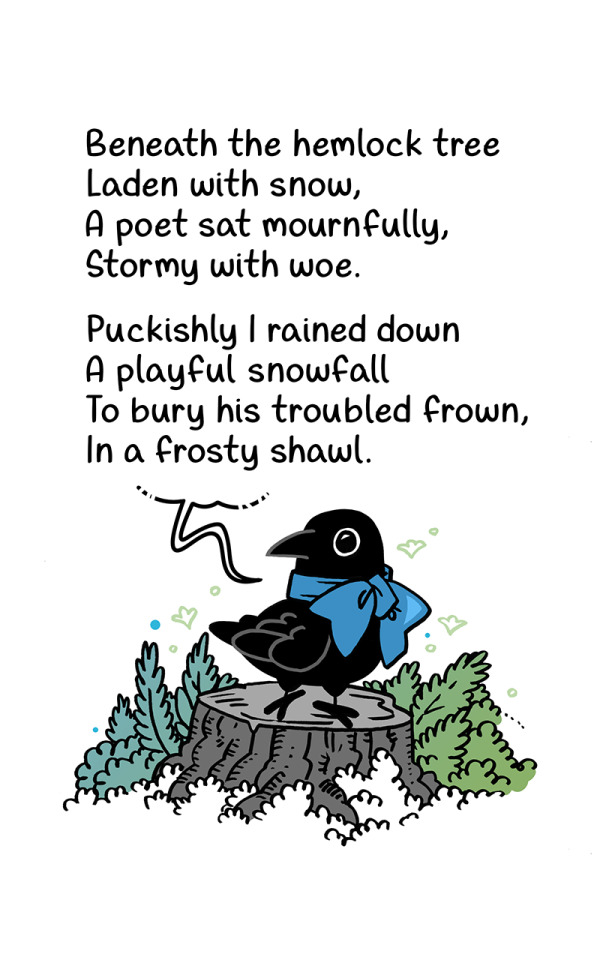
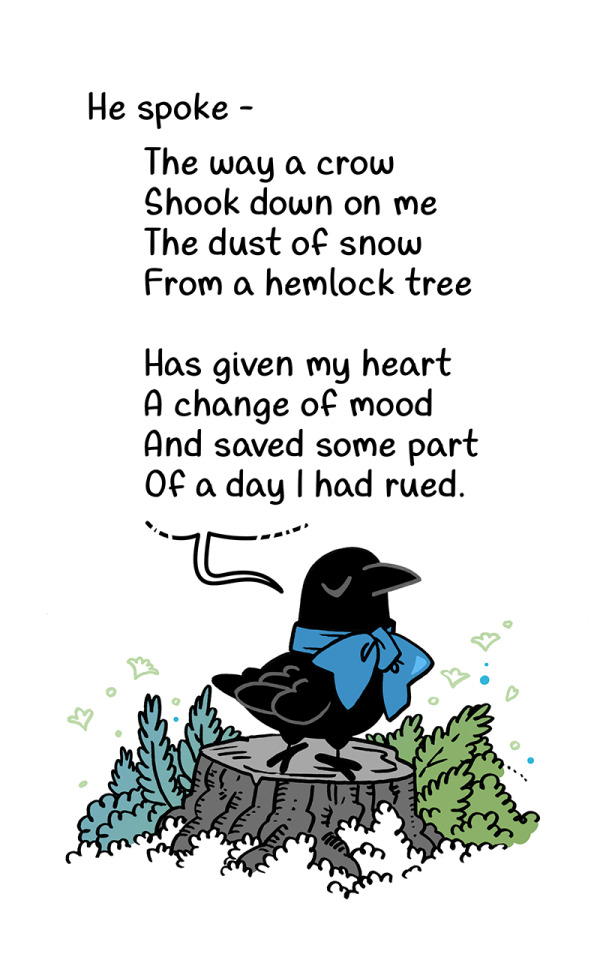

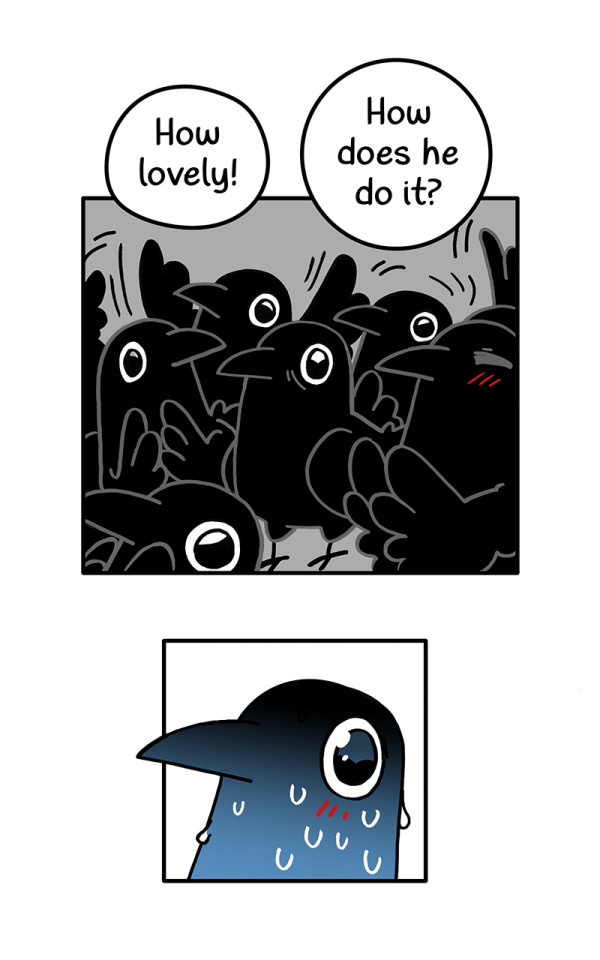
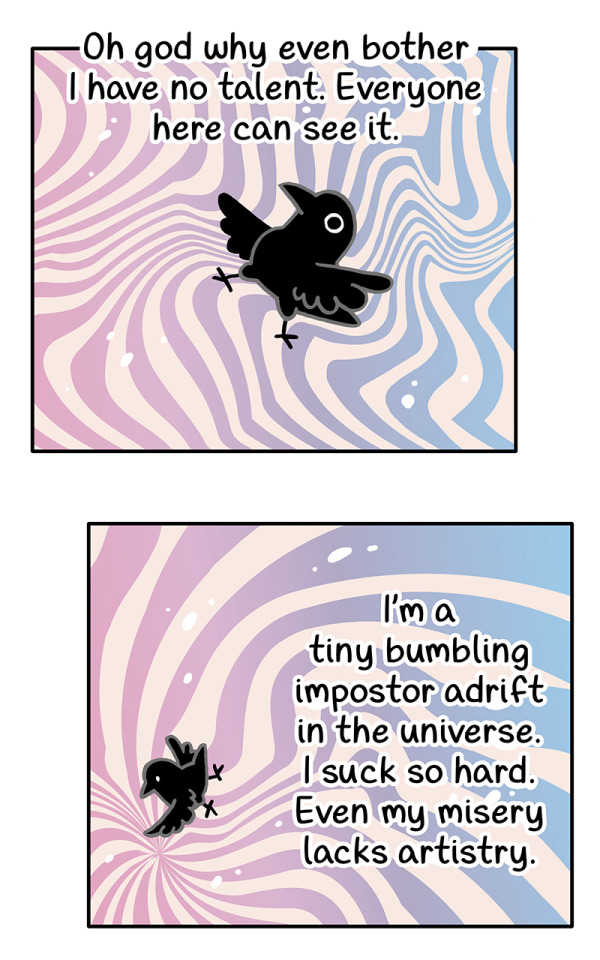

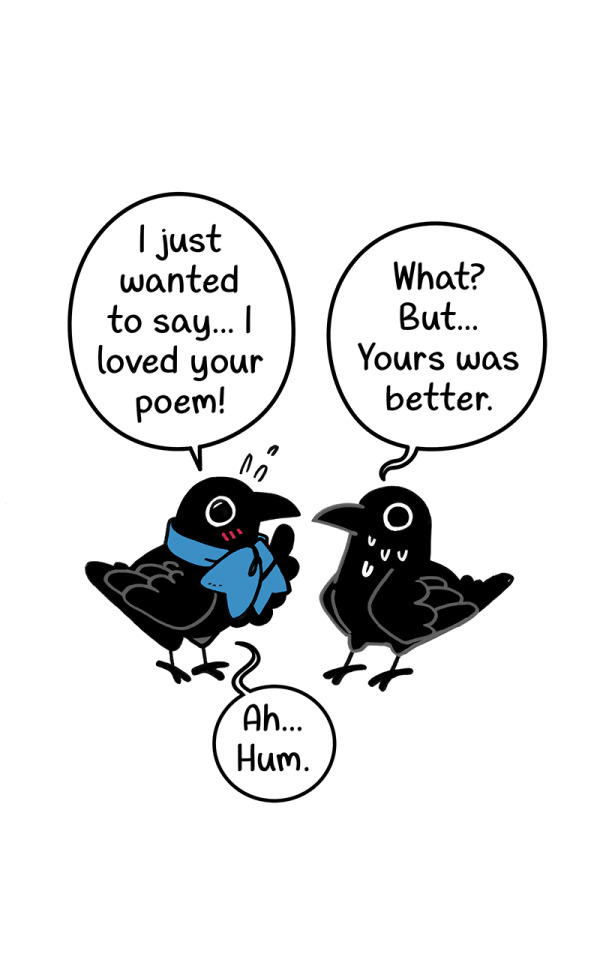
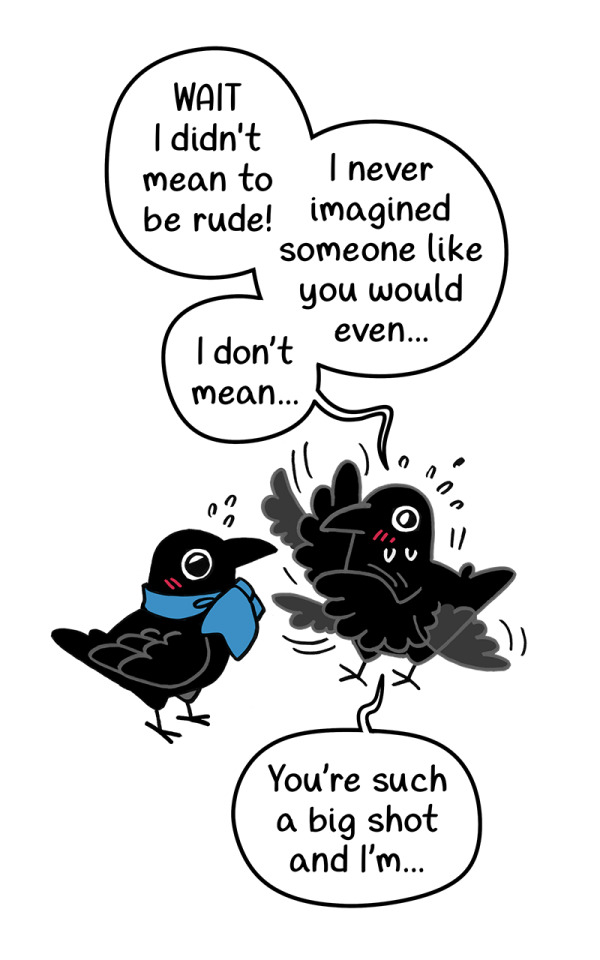
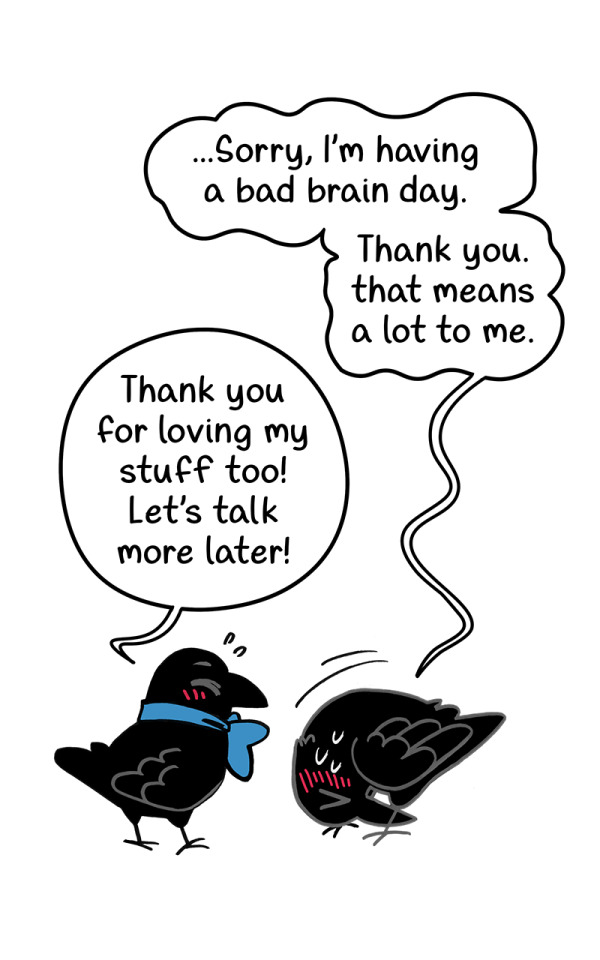
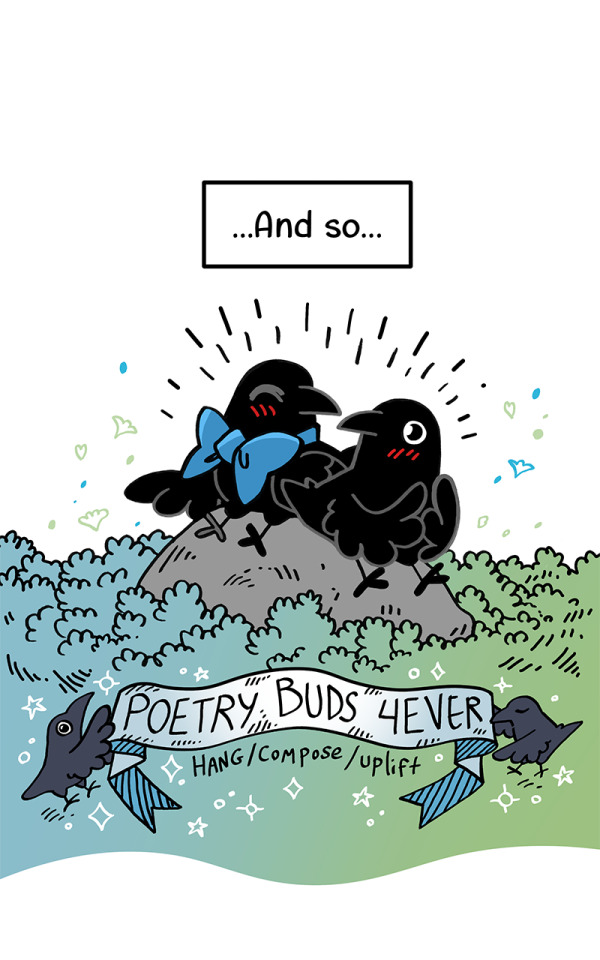
Poetry? More like CROWETRY!
Read Crow Time // Read Namesake // Patreon // Store
Crow Time Plush is now up for sale!
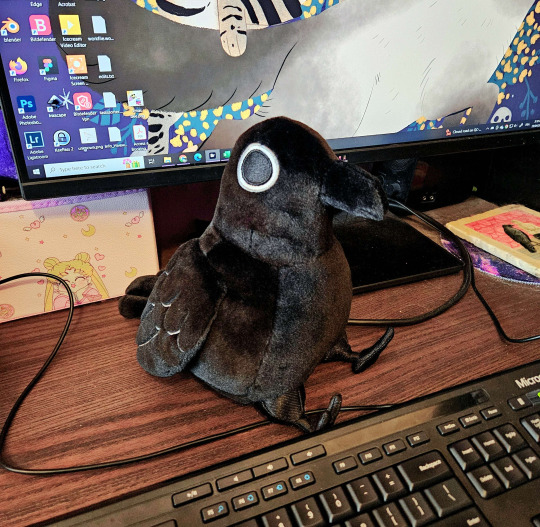
27K notes
·
View notes